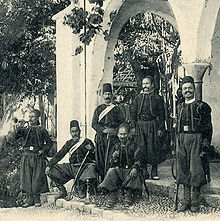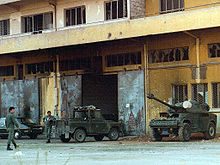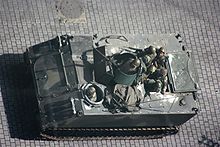- Lebanese Armed Forces
-
Lebanese Armed Forces
Al-Quwwāt al-Musallaḥa al-Lubnāniyya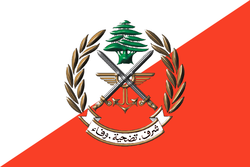
Flag of the Lebanese ArmyFounded August 1, 1945 Current form 1983 and 1991 Service branches Ground Forces
Air Force
NavyHeadquarters Yarzeh, Beirut Leadership Commander-in-Chief Jean Kahwaji (2008- ) Minister of National Defense Fayez Ghosn Chief of Staff Walid Salman (2011- ) Manpower Military age 18-30 years of age for voluntary military service Conscription No (abolished in 2007) Available for
military service1,106,879 males, age 18-49,
1,122,595 females, age 18-49Fit for
military service934,828 males, age 18-49,
948,327 females, age 18-49Active personnel 56,000 Expenditures Budget $0.875 billion 2009 Industry Foreign suppliers  United States
United States
 France
France
 United Kingdom
United Kingdom
 UAE
UAE
 Germany
Germany
 Russia
RussiaRelated articles History 1948 Arab-Israeli War
1958 Lebanon crisis
The War over Water
Lebanese Civil War- Battle of the Hotels
- Hundred Days' War
- Mountain War
- War of the Camps
Operation Dinnieh
Operation Benin
2006 Lebanon War
Operation Nahr el Bared
2008 conflict in LebanonRanks Military Ranks The Lebanese Armed Forces (LAF) (Arabic: القوات المسلحة اللبنانية | Al-Quwwāt al-Musallaḥa al-Lubnāniyya) or Forces Armées Libanaises in French, also known as the Lebanese Army according to its official Website[1] (Arabic: الجيش اللبناني| or "Armée libanaise" in French, is the military of the Republic of Lebanon. It consists of three branches, the army, the air force and the navy. The motto of the Lebanese Armed Forces is "Honor, Sacrifice, Loyalty" (Arabic: "شرف · تضحية · وفاء" - Sharaf.Tadhia.Wafa'). The Lebanese Armed Forces Emblem consists of a Lebanon Cedar tree surrounded by two laurel leaves, positioned above the symbols of the three branches: the ground forces represented by the two swords, the navy represented by an anchor, and the air force represented by two wings.
Contents
General overview
The Lebanese Armed Forces' primary missions include defending Lebanon and its citizens against external aggression, maintaining internal stability and security, confronting threats against the country's vital interests, engaging in social development activities and undertaking relief operations in coordination with public and humanitarian institutions.[2]
The LAF consists of 56.000 active personnel[3] with the Land forces consisting of approximately 54.000 troops, the air & air defense forces consisting of about 1.000 personnel and another 1.000 in the naval forces. All three branches are operated and coordinated by LAF Command, which is located in Yarzeh, east of Lebanon's capital, Beirut. Currently the LAF is ranked 6th in the world in terms of growth, with the number of military personnel doubling over the period between 1985 to 2000.[4] The country has six military colleges and schools. The Lebanese officers are sent to other countries such as Russia or Europe to receive additional training.
The equipment of the LAF is outdated due to lack of funds, political bickering and until recently the presence of foreign forces.[citation needed] After the conclusion of the Lebanese Civil War, the LAF decided to repair as much of its equipment as it could, while being aided by modest donations from other nations. About 85% of the LAF's equipment is American-made with the remaining being British, French, and Soviet-made.[5]
History
The Lebanese Army first formed under Prince Fakher el-Din II the Great in the early 17th-century during the Principality of Lebanon (1516-1840). The first major victory came on October 31, 1622 against the Syrian army of the Pasha of Damascus in the Battle of Majdel Anjar. Outnumbered (5,000 Lebanese soldiers against 12,000 Syrians), Fakher el-Din was nevertheless victorious and was able to capture the Pasha of Damascus for himself.[6]
During the period of the semi-autonomous province (Mutasarrifia) period of Mount Lebanon between 1861 and 1914, no Turkish troops were allowed to station within its boundary. Lebanon established its own army made up of volunteer militias; "the free independent bearing of these mountaineers was in striking contrast to that of the underpaid, underfed and poorly clothed conscripts of the regular [Turkish] army".[7]
The beginnings of the modern army arose during 1916, when the French government established the "Legion of the Orient", which included Lebanese soldiers.[8] After a post World War I League of Nations mandate was established over Lebanon in April 1920, France formed the Army of the Levant, which was later reorganized into the "Troupes Spéciales du Levant" (Special Troops of the Levant). These troops were composed of Lebanese and Syrian enlisted personnel, but were commanded predominantly by French officers; however, the percentage of Lebanese and Syrian officers in the force gradually increased in size to approximately 90% of the total number by 1945.[9]
Later in 1926, the Lebanese First Sharp Shooters Unit was created out of the Special Troops of the Levant; it is considered to be a direct precursor to the Lebanese Armed Forces (LAF).[8]
During World War II, Lebanese troops fought in Lebanon with the Vichy French forces against Free French and British forces. After the Vichy forces in the Middle East surrendered in July 1941, volunteers from the Troupes Spéciales du Levant enlisted in the Free French forces and participated in combat in Italy, North Africa, and southern France.[9] In 1943, prior to the declaration of Lebanese independence, all the military units were combined in one brigade, the Fifth Brigade, under the command of General Fouad Chehab. On the day Lebanon declared independence, the Lebanese Third Sharp Shooters Regiment was placed at the disposal of the Lebanese government in order to maintain security. In June of the same year, the French reconstituted units of the Troupes Spéciales du Levant, which were then attached to the British forces in the Middle East. The majority of the Lebanese Armed Forces remained a part of the French Army in Lebanon.[9]
After gaining independence in 1943, the Lebanese government formed an official delegation in 1944 to negotiate with the French the terms related to handing over the LAF. After nearly three weeks of talks, the joint French-British Command decreed that responsibility for armed units under French control were to be handed over to the Independent Government of Lebanon.[8] These units were part of the Troupes Spéciales du Levant and totaled about 3,000 men.[9] On August 1, 1945 at 00:00 hours, the LAF was placed under full authority of the Lebanese National Government; this day is commemorated annually as Lebanese Army Day.[8]
After establishing authority over the LAF in 1945, the Lebanese government intentionally kept its armed forces small and weak due to the country's unique internal politics. Christian politicians feared that Muslims might use the armed forces as a vehicle for seizing power in a military coup. They also appeared unwilling to incur the cost of maintaining a large well equipped army.[9] Throughout the 1950s and 1960s, Lebanon never spent more than 4% of its GNP on the military budget.[9] Many Christian Lebanese also feared that a large army would inevitably force Lebanon into the Arab–Israeli conflict. However, Muslim politicians were also worried that a strong army could be used against Muslim interests because it would be commanded by Christians. At the same time they tended to feel that the military should be strong enough to play a part in the Arab-Israeli struggle.[9] In addition to the two major conflicting views, prominent Lebanese politicians of the myriad religious denominations in Lebanon have also tended to be feudal warlords commanding their own private militias and feared that a strong army would endanger their personal power.[9]
In 1948, the Lebanese Third Sharp Shooters Regiment fought Israeli Forces occupying the Lebanese village of Malkieh in the northern Galilee and captured it, and that by the orders of Lebanese defense minister then, Emir Majid Arslan II.[8][10] This was the first major combat operation for the Lebanese Armed Forces under the Independent Lebanese Government.
Branches
Armed Forces Command
The LAF Command is headquartered at Yarzeh. The organizational structure of the LAF Command includes:
- The Commander-in-Chief
- The Chief of staff
- Deputy Chiefs of Staff
- Various Directorates
Lebanese Ground Forces
The Lebanese Armed Forces' strength lies in their ground forces which is by far the largest of the three branches of the military.
The Fourth Brigade was previously active but was disbanded in 1984.
The Lebanese Army Ground Forces consist of:
- 5 Regional Commands
- Beirut Region.
- Bekaa Region.
- Mount Lebanon Region.
- North Region.
- South Region.
- 11 Mechanized Brigades
- Heavy Brigades
- First Brigade.
- Second Brigade.
- Third Brigade
- Fifth Brigade
- Sixth Brigade
- Light Brigades
- Seventh Brigade
- Eighth Brigade
- Ninth Brigade
- Tenth Brigade.
- Eleventh Brigade
- Twelfth Brigade
- Heavy Brigades
- First Artillery Regiment
- Second Artillery Regiment.
- Commando Regiment.
- Includes the Mountains Combat Company.
- Airborne Regiment.
- Navy SEALs Regiment.
- Counter-Sabotage Regiment (Moukafaha)
- First Intervention Force Regiment
- Second Intervention Force Regiment
- Third Intervention Force Regiment
- Fourth Intervention Force Regiment
- Fifth Intervention Force Regiment
- Republican Guard Brigade.
- Medical Brigade.
- Support Brigade
- Logistics Brigade
- Military Police.
- Independent Construction Regiment.
- First Armored Regiment.
- First Land Border Regiment
Lebanese Ground Forces Equipment
Main article: Lebanese Ground Forces EquipmentSee also: Lebanese Armed Forces Out of Service EquipmentThe Lebanese Army still uses equipment mostly received through donations or friendly prices. Its work horse is the M113 which is commonly used by every regiment and brigade. A collection of Western and Soviet made arms and equipment exists ranging from rifles to tanks. However, the Lebanese army is trying to rearm and modernize itself through new aids and purchases from different countries such as the US, Belgium, Russia, and The Netherlands. A list of awaiting-for-delivery equipment is constantly growing and includes Leopard 1/A5 tanks,[11][12] more M60 Patton tanks,[13][14] M198 Howitzers, etc. A recent Russian promise to supply Lebanon with T-90 tanks has been in discussion since the Lebanese Defense Minister's last visit to Russia on December 16, 2008.[15]
Throughout history the Lebanese Army employed different arms and equipment which, at the time, were considered state of the art. Most of these arms have either been phased out of service or sold to other countries. Among the major equipment that is not currently active are AMX-13, Saladin, Panhard M3, and Staghound.
Lebanese special forces
Lebanese Armed Forces
Organization Ministry of National Defense Lebanese Air Force Lebanese Navy Lebanese Special Forces Lebanese Red Cross Personnel LAF Commanders Lebanese Military Personnel Topics of Lebanon Culture - Geography History - Politics Main article: Lebanese Special Operations CommandThe Lebanese Special Forces are the elite of the Lebanese army, those who enroll are subjected to rigorous training regimes and must be in peak physical and mental condition prior to their ascension to such a highly desired position. Each branch of the Armed Forces consist of their own form of Special Forces or Commandos. These include:
- Navy Commando Regiment (Navy SEALs)
- Commando Regiment (Also known as the Maghaweer)
- Airborne Regiment (Moujawkal)
- Counter-Sabotage (Moukafaha) Branch and the Strike Force (Kouwa el-Dareba) Anti-Terrorism Branch
To ensure the effectiveness of such an elite force, many Commandos are sent overseas to nations such as the US, UK and France to receive extra training in specialized areas that the Lebanese Armed Forces are unable to provide, due to a lack of resources. While training in Lebanon, each Commando is instructed in the art of urban and guerrilla warfare. So rigorous is their domestic training regime that each commando is subjected to a training timetable consisting of 20 hours per day for 3 months, which is divided into different stages. Each stage consists of a specialized form of warfare and its associated tactics. Such tactics include: sabotage, sniping, extraction and covert operations. The Lebanese Special Forces are also well known for killing and eating snakes with their bare hands at graduation ceremonies.[16][17]
In 2008, the Lebanese Army started establishing the Special Operations command in order to group the Army's elite units. These Special Operations forces will include the Airborne Regiment, the Commandos Regiment,the Navy Commandos Regiment, and the Counter-Sabotage Regiment of the Military Intelligence. The initial size of the force will be less than two brigades, around 5,000 troops, but the plan is to enlarge it up to three brigades.[18]
The Lebanese Navy is responsible for protecting Lebanon's territorial waters, ports, and fighting illegal smuggling of goods. The structure of the navy is centralized around the Navy Command, then it branches off into the quarter-general of the Navy, the Department of Naval Equipment Stores, the Naval School, Beirut Naval Base and the Jounieh Naval Base.
The navy, which currently lacks the suitable amount of equipment, has a number of approximately 50 vessels of various sizes and roles; however, the navy is trying to modernize itself, and increase its size.
Lebanese Air Force
The Lebanese Air Force is the air force branch of the Lebanese Armed Forces. It currently has a number of helicopters including the UH-1H Bell Huey, Gazelle, and various others. The air force is currently in the process of restoring its jet capabilities and considering the purchase of a small number of fighters or jet trainers.
Colleges and schools
The Lebanese Armed Forces has six official military colleges and schools that serve a wide variety of functions from officer training to overseeing national youth conscription programs. The recent emphasis on the First Flag Service Center is designed to help overcome the diverse nature of the population. The schools and colleges are:
- Fouad Shehab Command and Staff College
- High Center for Military Sport
- Military Academy
- Skiing and Mountain Fighting School
- Teaching Institute
- Air Force Aviation School
- Naval Academy
- Special Forces School
The Staff and Command College, Military Academy, and Mountain Skiing Fighting School are training centers for Lebanese soldiers designed to upgrade the quality of their skills while the High Center for Military Sport is designed to keep them in peak physical shape (it also organizes sports groups and teams for international competition as well). The Training Institute is designed to help soldiers specialize in certain aspects of the military, such as artillery and defense.[19]
Military ranks
Generals
Insignia 'Imād Liwā' 'Ameed Senior officers
Insignia Title Colonel Lieutenant Colonel Major 'Aqeed Muqaddam Rā'id Junior officers
Insignia Title Captain First Lieutenant Second Lieutenant Naqeeb Mulāzim 'Awwal Mulāzim Non-commissioned officer ranks
Insignia Title Chief Warrant Officer Warrant Officer First Adjutant Adjutant Sergeant First Class Sergeant Mu'ahhal 'Awwal Mu'ahhal Muaāwin 'Awwal Muaāwin Raqeeb 'Awwal Raqeeb Enlisted men
Insignia Title Corporal First Class Corporal Soldier First Class Third year Cadet Second year Cadet First year Cadet 'Areef 'Awwal 'Areef Jundi 'Awwal Telmeez Ḍabit Telmeez Ḍabit Telmeez Ḍabit Sana Thālitha Sana Thāniya Sana 'Oula Camouflage patterns
Image 


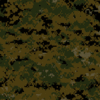
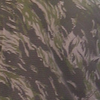
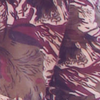

Name US Woodland ARPAT 3-tones brown ARPAT MARPAT Woodland Tigerstripe Camouflage Lizard Camouflage Black Camouflage Users All units Navy SEALs Regiment Airborne Regiment Commando Regiment Commando Regiment Moukafaha Navy SEALs Regiment Combat history
Lebanese Civil War
As the civil war escalated, Lebanese militias grew stronger and soon surpassed the regular army. This rapidly undermined the authority of the central government. The government's ability to maintain order was also handicapped by the nature of the Lebanese Army. One of the smallest in the Middle East, it was composed based on a fixed ratio of religions. As members defected to sectarian militias, the army would eventually prove unable to contain the militant groups, rein in the PLO or monitor foreign infiltration. Since the government was Christian-dominated, especially the officers' ranks, trust among Muslims for central institutions, including the army, was low. The disintegration of the Lebanese Army was eventually initiated by Muslim deserters declaring that they would no longer take orders from the Maronite generals.
Dinnieh fighting
During December 1999-January 2000 an Islamic group launched a failed uprising against the Lebanese authorities in the Dinnieh district. In a period of 8 days of fighting in the snow-blanketed mountains east of the northern port of Tripoli, 14 soldiers and 25 rebels were killed.[20]
2006 Lebanon War
In the 2006 Lebanon War the LAF did not engage in a direct conflict with the Israeli Army, despite its threat of retaliation if the IDF pushed too far northward into Lebanon. However, the latter did bomb several Lebanese military bases.[21][22][23] While providing aid to civilians, Lebanese troops helped to uphold order in city streets, directed refugees to safer areas, and assisted with overlooking damage done by Israeli attacks.[21] On several occasions, Lebanese troops fired anti-air weapons at Israeli aircraft,[24] but no damage was documented. Overall, 49 Lebanese soldiers were killed.[25]
After the July war the LAF deployed south of the Litani River for the first time since 1968 to enforce Security Council Resolution 1701. The LAF says it will not, and cannot, disarm Hezbollah by force. On February 7, 2007, the Lebanese army fired at an Israeli Bulldozer that moved close to the border and crossed it, Israel fired back, there was no casualty reports, the UNIFIL stationed in the south described the shootout as a "serious incident".
2007 North Lebanon conflict
The 2007 Lebanon conflict began when fighting broke out between Fatah al-Islam, a militant organization, and the Lebanese Armed Forces on May 20, 2007 in Nahr al-Bared, a Palestinian refugee camp near Tripoli. It has been the most severe internal fighting since Lebanon's 1975–90 civil war. The conflict evolved mostly around the Siege of Nahr el-Bared. There was heavy use of the Lebanese artillery in that area to eliminate snipers posted around the cities. The conflict finally ended on September 2, 2007 with the Lebanese Army taking control of the camp after more than three months of heavy fights and a death toll of 155 Commandos and Infantrymen. The LAF Engineering Corps achieved what was seen as a feat of ingenuity during the conflict where they converted a number of UH-1 helicopters into bombers, arming them with 250 kg and 400 kg conventional bombs from old Hunter and Mirage III fighter jets. Some helicopters were also fitted with French Matra rocket pods. This was, according to observers, a decisive step that considerably shortened the conflict.[26]
2008 fighting in Lebanon
Main article: 2008 fighting in LebanonDuring the week-long clashes that occurred at the beginning of May 2008 in Beirut and other regions of the country, the army was unable to prevent rival Lebanese groups from fighting each other. This was because the army, along with the government, had thought it would have been better if rival groups would eventually end the violence and sort out the dispute between them, alone, other than involving the national army which may had led to great divisions between the soldiers, just like in the civil war. It would have also caused an out cry to the soldiers that could have died, leading to even greater divisions and blame to the political forces.[27] However, whenever ceasefire was brought into action in a specific area or district in Beirut or else where in the country, the LAF would straight away enforce peace. On May 13, the national army had announced that if the clashes would not end as soon as possible, it would have to intervene and use force if necessary to stop them.[28]
Conscription
Lebanon previously had mandatory military service of one year for men. On May 4, 2005, a new conscription system was adopted, making for a six-month service, and pledging to end conscription within two years. As of February 10, 2007 mandatory military service no longer exists in Lebanon thus making it a conscription-free all-volunteer force.[29]
Training
Training of new conscripts takes place in the First Flag Service Center (FFSC). After a week of enlisting, they submit to two training courses, the common military training basic course and the specific course. All these courses are organized in details according to a program determining hours of training taking into consideration the conscript rank.[30] The first course consists of 240 hours equivalent to 9 weeks and the training program is composed of:
- Military rules and regulations
- Technical and tactical education
- Weapons
- Physical fitness
- Orientation and moral preparation
The second course consists of 84 hours equivalent to three weeks. The infantry course is composed of:
See also
- Internal Security Forces
- General Security Directorate (Lebanon)
- United Nations Interim Force in Lebanon
References
- ^ http://www.lebarmy.gov.lb/?ln=en
- ^ "LAF Mission". Lebanese Armed Forces. http://www.lebarmy.gov.lb/english/mission.asp. Retrieved 2009-05-19.
- ^ "Lebanese Armed Forces, CSIS (Page 78)" (PDF). 2009-02-10. http://www.carnegieendowment.org/files/090210_lafsecurity3.pdf.
- ^ "Armed forces growth (most recent) by country". NationMaster.com. 2002. http://www.nationmaster.com/graph/mil_arm_for_gro-military-armed-forces-growth. Retrieved December 13, 2008.
- ^ "LAF Equipment". Lebanese Armed Forces. http://www.lebarmy.gov.lb/English/Equipments.asp. Retrieved 2009-05-19.
- ^ "معركة عنجر - تفاصيل الموقعة وأسر والي دمشق" (in Arabic). Kadmous. July 5, 2004. http://kadmous.org/wp/?p=27. Retrieved 2009-05-19.
- ^ LEARY, LEWIS GASTON (November, 1913). "2". Syria, The Land of Lebanon. New York: McBbidk, Nast & Co.. p. 16. ISBN 978-1-4446-7401-9. http://www.archive.org/stream/syrialandofleban00learuoft/syrialandofleban00learuoft_djvu.txt. Retrieved Januar 1, 2009.
- ^ a b c d e "LAF History". Lebanese Armed Forces. http://www.lebarmy.gov.lb/english/history.asp. Retrieved 2009-05-19.
- ^ a b c d e f g h "Lebanese Ground Forces". GlobalSecurity.org. http://www.globalsecurity.org/military/world/lebanon/army.htm. Retrieved December 8, 2008.
- ^ Khalidi, Walid. (1992). All That Remains. Institute of Palestine Studies, p.471.
- ^ "Feu vert pour la vente d’armes belges au Liban" (in French). RTL info (Mouvement pour le Liban). August 27, 2008. http://mplbelgique.wordpress.com/2008/08/27/feu-vert-pour-la-vente-darmes-belges-au-liban/. Retrieved 2008-12-11.
- ^ "Le Liban achète 71 blindés à la Belgique" (in French). RTL Info. December 31, 2007. http://www.rtlinfo.be/rtl/archive/article/76972/?&archiveYear=2007. Retrieved 2008-12-11.
- ^ "M60 Main Battle Tanks From U.S. to Lebanese Army". Nahar Net. November 21, 2008. http://www.naharnet.com/domino/tn/NewsDesk.nsf/0/61B674E90F28A4DBC22575080030DE77?OpenDocument. Retrieved November 21, 2008.
- ^ Garamone, Jim (December 1, 2008). "U.S. Forces Help Lebanese Military Assert Control". American Forces Press Service - DefenseLink News. http://www.defenselink.mil/news/newsarticle.aspx?id=52128. Retrieved 2008-12-10.
- ^ Daragahi, Borzou; Rafei, Raed (December 18, 2008). "Russia to donate 10 fighter jets to Lebanon". Los Angeles Times. http://articles.latimes.com/2008/dec/18/world/fg-russia-lebanon18. Retrieved May 19, 2009.
- ^ http://www.lebarmy.gov.lb/English/popup.htm?/images/album/13/21.jpg
- ^ http://www.lebarmy.gov.lb/English/popup.htm?/images/album/13/22.jpg
- ^ Kahwaji, Riad (January 21, 2008). "Special Operations Command, More Military Aid for Beirut". Defense News. http://www.defensenews.com/story.php?i=3308844
- ^ "Military Colleges & Schools". GlobalSecurity.org. http://www.globalsecurity.org/military/world/lebanon/schools.htm. Retrieved December 12, 2008.
- ^ Gambill, Gary C.; Endrawos, Bassam (September). "Bin Laden's Network in Lebanon". Middle East Intelligence Bulletin. http://www.meib.org/articles/0109_l1.htm
- ^ a b http://www.lebarmy.gov.lb/article.asp?ln=ar&id=11546+(July 2006). (in Arabic)Lebanese Army Magazine (Lebanese Armed Foces) (253).
- ^ "Israel bombs Lebanese army barracks". News.com.au. July 18, 2006. http://www.news.com.au/adelaidenow/story/0,22606,19828653-5005962,00.html. Retrieved 2009-05-19.
- ^ "IAF strikes Lebanese Air Force base". Jerusalem Post. 2006-07-13. http://fr.jpost.com/servlet/Satellite?cid=1150885985413&pagename=JPost/JPArticle/ShowFull. Retrieved 2006-07-13.
- ^ "Lebanese army stops Israeli helicopters landing". Reuters. 2006-07-30. http://www.alertnet.org/thenews/newsdesk/L30832182.htm.
- ^ "شهداء حرب تموز" (in Arabic). Lebanese Armed Forces. http://www.lebarmy.gov.lb/martyrs.asp?ln=ar&id=12397. Retrieved 2009-05-19.
- ^ "Lebanon army takes control of camp after battle". Reuters. September 2, 2007. http://www.reuters.com/article/topNews/idUSL0261343920070902R.[dead link]
- ^ "Gunbattles break out in Beirut". CNN. May 9, 2008. http://www.cnn.com/2008/WORLD/meast/05/08/lebanon.hezbollah/index.html. Retrieved 2008-05-08.
- ^ "Lebanese army deploys troops around the country to impose law and order by force". Fox News. http://origin.foxnews.com/story/0,2933,355304,00.html. Retrieved 2008-05-19.
- ^ [1], Lebanese Army (official website)[dead link]
- ^ "Training in the FFSC". Lebanese Army website. http://www.lebarmy.gov.lb/English/CollegesMilitaryServiceMain.asp#tadrib. Retrieved 2008-12-28.
External links
- Lebanese Armed Forces (LAF) Official Website
- Lebanon Military Guide from GlobalSecurity.org
- CIA - The World Factbook - Lebanon
- Army Recognition Index of Lebanese Military Equipment
- Global Fire Power - Lebanon Military Strength
- Lebanon army trying to rearm and modernize itself
- Lebanese Military Wish List 2008/2009 - New York Times
- MilitaryPhotos.Net, Lebanese Army - Photos Thread
- MilitaryPhotos.Net, Lebanese Army - Discussions Thread
 Military of Lebanon
Military of LebanonOrganization Service SectionsBranchesRanksCivilian auxiliariesUnified CommandsSpecial Operations CommandColleges & SchoolsFouad Shehab Command and Staff College · Military Academy · Teaching Institute · Skiing and Mountain Fighting School · High Center for Military Sport · Naval Academy · Aviation SchoolUnits Operations & History Bases Air ForceGround ForcesNorth Region CommandBahjat Ghanem military base · Youssef Rahmeh military base · George al-Nghayweh military base · Nohra al-Shalouhi military baseSouth Region CommandNavyBeirut Naval BasePersonnel Commanders of the Lebanese Armed Forces · Lebanese Military PersonnelDevelopments  Lebanon topics
Lebanon topicsHistory 
Politics Constitution · President · Prime Minister · Political parties · Foreign relations · Military · Human rights (LGBT rights)Geography Mount Lebanon · Beqaa · Anti-Lebanon mountains · Cities · Governates · Districts · South Lebanon · Sheeba FarmsEconomy Central Bank · Transport · Tourism · Communications · Agriculture · International rankings · Lebanese PoundCulture WikiProject Lebanon Military of Asia Sovereign
states- Afghanistan
- Armenia
- Azerbaijan
- Bahrain
- Bangladesh
- Bhutan
- Brunei
- Burma (Myanmar)
- Cambodia
- People's Republic of China
- Cyprus
- East Timor (Timor-Leste)
- Egypt
- Georgia
- India
- Indonesia
- Iran
- Iraq
- Israel
- Japan
- Jordan
- Kazakhstan
- North Korea
- South Korea
- Kuwait
- Kyrgyzstan
- Laos
- Lebanon
- Malaysia
- Maldives
- Mongolia
- Nepal
- Oman
- Pakistan
- Philippines
- Qatar
- Russia
- Saudi Arabia
- Singapore
- Sri Lanka
- Syria
- Tajikistan
- Thailand
- Turkey
- Turkmenistan
- United Arab Emirates
- Uzbekistan
- Vietnam
- Yemen
States with limited
recognition- Abkhazia
- Nagorno-Karabakh
- Northern Cyprus
- Palestine
- Republic of China (Taiwan)
- South Ossetia
Dependencies and
other territories- Christmas Island
- Cocos (Keeling) Islands
- Hong Kong
- Macau
Military ranks and insignia by country Africa Egypt (Army · Air Force · Navy) · South Africa · Tanzania
Americas Asia Burma · People's Republic of China (Army · Navy · Air Force) · Republic of China · India (Army · Air Force · Navy) · Indonesia · Iran (Army · Navy · Air Force) · Iraq · Israel · Japan · Jordan · Korea · Lebanon · Pakistan · Saudi Arabia · Singapore · Sri Lanka (Army · Navy · Air Force) · Thailand · Vietnam
Former: Imperial Japan (Army · Navy)Europe Albania · Austria · Belgium · Bosnia and Herzegovina · Bulgaria · Croatia · Denmark (Army · Navy · Air Force) · Estonia · Finland · France (Army · Navy · Air Force) · Germany · Greece · Hungary · Iceland (Land Forces · Coast Guard) · Ireland (Army · Naval Service · Air Corps) · Italy (Army · Navy · Air Force) · Macedonia · Monaco · Netherlands · Norway · Poland · Portugal · Romania · Russia (Army · Navy · Air Force) · Serbia · Slovenia · Spain (Army · Navy · Air Force) · Sweden · Switzerland · Turkey · Ukraine · United Kingdom (Navy · Army · Air Force) · Vatican
Former: Austria–Hungary · East Germany · Nazi Germany (Volkssturm · SA · SS) · Kingdom of Greece (Army · Navy) · Soviet Union · Yugoslavia · Serbia and MontenegroOceania Categories:- Military of Lebanon
Wikimedia Foundation. 2010.


